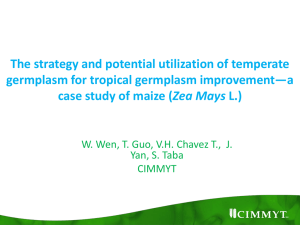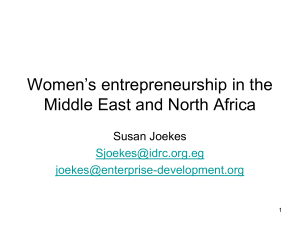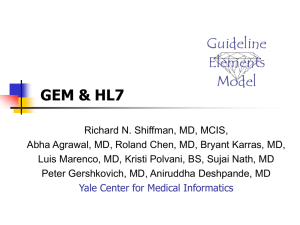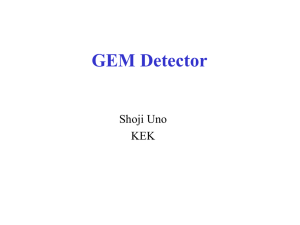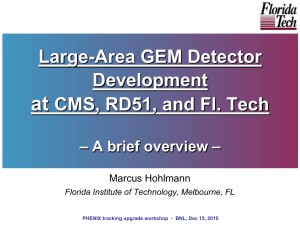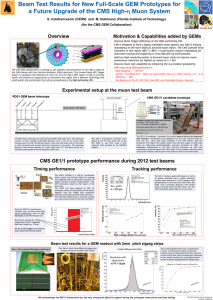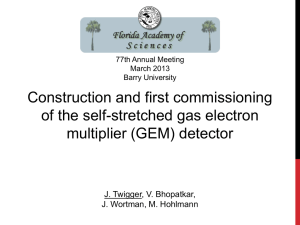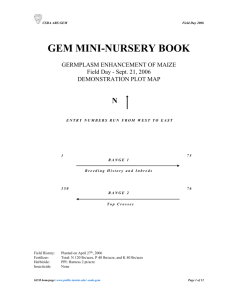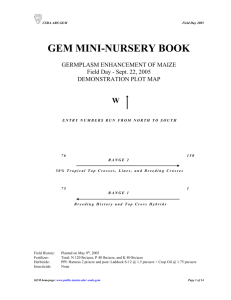Blanco_Corn_School_0.. - Iowa State University
advertisement
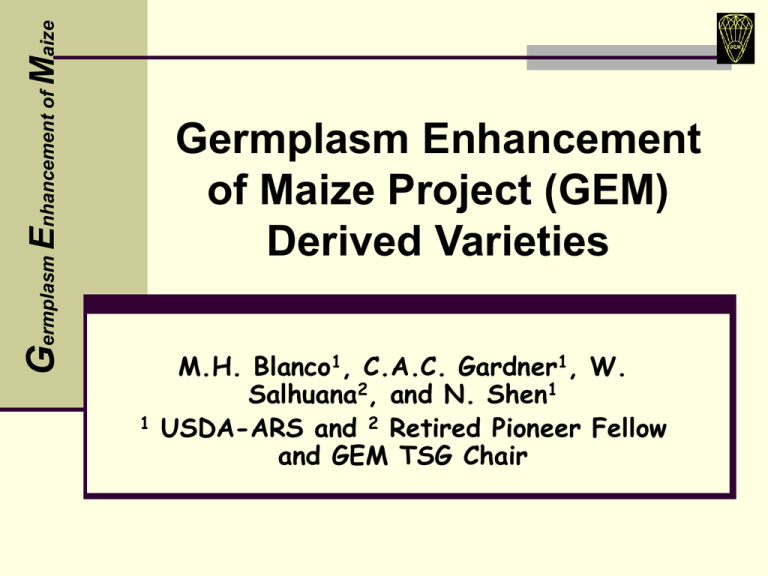
Germplasm Enhancement of Maize Germplasm Enhancement of Maize Project (GEM) Derived Varieties 1 M.H. Blanco1, C.A.C. Gardner1, W. Salhuana2, and N. Shen1 USDA-ARS and 2 Retired Pioneer Fellow and GEM TSG Chair GEM Mission Statement The objective of the GEM Project is to develop and provide to the public adapted germplasm lines via germplasm enhancement of useful exotic germplasm. The adapted materials are incorporated into research and breeding programs that will increase the diversity of U.S. corn germplasm, improve its performance, and provide new and better products to the American consumer. Countries Belonging to the Latin American Maize Project (LAMP) * Argentina Bolivia Brazil Columbia Chile Guatemala Mexico Paraguay Peru United States Uruguay Venezuela * LAMP began in 1987, funded by Pioneer Hi-Bred Int., Inc., and administrated by the USDA-ARS. GEM Objectives Manage an extensive multi-site cooperative breeding (and trial network) and information sharing with public and private cooperators. Develop genetically enhanced populations and lines (early generation S2 and S3 focus) from GEM breeding crosses. Evaluate genotypes in the breeding program for yield, agronomic traits, silage, biotic and abiotic stress (including mycotoxins), and value-added traits. Conduct research relevant to high priority maize germplasm traits and performance. Private GEM US Cooperators AgReliant Genetics, LLC BASF Plant Science Breeding, L.L.C Beck's Superior Hybrids, Inc.* Benson Seed Research, LLC FFR Cooperative Garst Seed Company* Golden Harvest Seeds, Inc. Hoegemeyer Enterprises Illinois Foundation Seeds, Inc. Monsanto Company* Mycogen Seeds* National Starch and Chemical Co. NC+ Hybrids* PAU Seeds, Inc. Pioneer Hi-Bred Int., Inc.* Professional Seed Research, Inc. Schillinger Seeds SEEDirect Syngenta Seeds, Inc.* Wyffels Hybrids * Entities with representatives currently serving on the GEM Technical Steering Group (TSG). Public US Cooperators Cornell University Iowa State University Louisiana State University Michael Fields Agricultural Institute1 North Carolina State University North Dakota State University Ohio State University Texas A&M University* The University of Tennessee 1 Truman State University University of Delaware* University of Illinois University of Nebraska University of Wisconsin USDA-ARS (Ames, IA) USDA-ARS (Columbia, MO) USDA-ARS (Mississippi State, MS) USDA-ARS (Raleigh, NC) Non-Government Organization (NGO) * Entities with representatives currently serving on the TSG. International Cooperators AgriSource Co., Ltd., Thailand Agrotuniche, Chile EMBRAPA1, Brazil Hyland Seeds, Canada INTA2, Argentina 1 2 Maharlika Genetics, Mexico Nidera, Argentina Sursem S.A., Argentina The University of Guelph, Canada Empresa Brasileira de Pesquisa, Agropecuaria (EMBRAPA); Brazil Instituto Nacioanal de Tecnologia Agropecuaria (INTA) Argentina GEM Trait Targets Agronomic adaptability- yield, lodging, grain moisture, and Y/M Abiotic stress tolerance: drought, heat, and interacting biotic stresses Ear mold and mycotoxin resistance (aflatoxin and fumonisin) Disease resistance (emphasis on stalk rots, and leaf blights that impact stalk rots) Insect resistance (emphasis on corn root worm and corn ear worm impacting quality and mycotoxins) Value-added traits (VAT’s) Grain (protein>13%, oil>6%, and starch>75%) Silage yield & quality GEM Pedigree Protocol First Accession Cross Second Cross Pedigree Status CUBA164:S20 50% tropical B.C. CUBA164 SS 20 NA CUBA164:S2012 25% tropical B.C. CUBA164 SS 20 SS 12 CUBA164:S2012 -444 S1 ear 444 CUBA164:S2012 -444-1 S2 ear 1 CUBA164:S2012 -444-1-B S3 "bulk" Legend: SS12 is stiff stalk inbred-company 12 SS 20 is stiff stalk inbred-company 20 GEM Breeding Protocol Flowchart Winter 1 Accession x Private line 1 Summer 1 (Accession x Private line 1) x Private line 2 Winter 2 Self 300 plants (S0) Summer 2 Plant S1 ears to make S2. Select at 20% selection intensity Winter 3 Make S2 topcross to elite tester inbred Summer 3 Yield test 50 S2 topcrosses at 6 locations Winter 4 Make S3 increase Summer 4 Summer 5 Winter 6 Determine quality analyses, disease & insect resistance in GEM lab or by cooperators Cross the S3’s to two testers Yield trial topcross from above Write release article for publication & all relevant data to NCRPIS Field Resources Required Populations Rows Needed S1 Nursery S2 Nursery Seed Increase ISO Rows Trial Plots 10 (in winter) 500 --- 600 --- --- 20 (in summer) 1000 7500 --- 3600 11400 S1 Nursery S2 Nursery Seed Increase ISO Rows Trial Plots 20 (in winter) 1000 --- 1200 --- --- 40 (in summer) 2000 15000 --- 7200 22800 Scenario 1 Scenario 2 GEM Germplasm Releases (105 Lines Total) Year # Lines Released Institution Germplasm Attributes 2001 1 USDA-ARS, IA GEM 001 is resistant to 1st brood ECB 2002 28 USDA-ARS, IA 25% and 50% exotics; temperate adapted 2002 2 U. Delaware 50% exotic; resistance to anthracnose stalk rot and gray leaf spot 2002 30 NC State U. 50% exotics; temperate adapted 2002 1 Ohio State U. GEMS-0002 is 50% exotic; good grain quality, earlier than B73 2003 16 USDA-ARS, IA 25% & 50% exotic; temperate adapted, VAT 2003 8 NC State U. 50% exotics; earlier flowering 2004 2 Texas A&M U. 25% exotic; stress tolerance, good GCA 2004 1 U. Wisconsin 25% exotic; high yielding silage with superior nutritional quality 2004 9 USDA-ARS, IA 25% exotic; temperate adaptation, VAT 2004 7 NC State U. 50% exotics; earlier flowering Released GEM Lines to the Public to Date Pedigree Derivation Comments GEMS-0001 PI 503806 x B94///B94 First gen. ECB resistant (non-DIMBOA) GEMS-0002 FS8A(S):S09-43-2 Early SS; stress tolerant DE 3 DKXL212:N11a-191 Good protein; GCA DE 4 DKXL212:N11a-365 GLS resistant; GCA Tx 204 AR01150:N0406 Stress tolerant; GCA Tx 205 AR01150:N0406 Stress tolerant; GCA UW EX 01* AR17026:N1019 Silage yield and quality * Projected for release in spring, 2005, by J. Coors, U. of WI. Expt. 02122 (6 Locations) with Tester LH200xLH198 in Year 2002 Stalk Root Moist Y/M Lodge Lodge Pedigree Yield BARBGP2:N08a18332-1 176.2 20.0 9.1 9.4 3.1 Test Entry Means 145.2 21.9 6.8 7.1 4.8 Check Means 174.2 20.9 8.5 8.1 4.3 CV 13.2 6.1 LSD (p=0.05) 22.5 1.5 Expt. 046011 (8 Locations) with Tester LH198 in Year 2004 Stalk Root Lodge Lodge Pedigree Yield Moist Y/M BARBGP2:N08a18332-1-B 183.1 19.7 9.4 1.9 1.0 Test Entry Means 175.4 19.7 9.0 2.1 2.4 Check Means 202.1 19.8 10.4 3.3 1.2 CV 9.6 6.5 LSD (p=0.05) 16.7 1.3 Quality Traits of 9 GEM Lines Released to GEM Cooperators in 2005 Pedigree Country (race) VAT BARBGP:N08a18-332-1-B Barbados (Tusón) CH05015:N1502-86-1-B Chile (Camelia) >14% protein CHIS775:S1911b-120-1-B-B Mexico (Tuxpeño) High TpG DK212T:N11a12-191-1-B Thailand (comm. DK) DKB844:S1601-73-1-B-B Mexico (comm. DK) Low TpG, low PHI, and wide RnG DREP150:N2011d-624-1-B Domin. Rep. (Mixed) >14% protein UR11003:S0302-1011-1-B Uruguay (Dente Branco) Narrow RnG DKB844:S1601-3-2 Mexico (comm. DK) >14% protein, Low TpG, low RnG, & high % R, CH05015:N1204-57-1 Chile (Camelia) >14% protein & >4.5% oil GEM Field Day Demo Silage Yield & Quality of EX 01 Grown in Wisconsin in 2004 Hybrid Yield Milk/ac (t/ac) (lbs) CP (%) NDF (%) IVD (%) EX01 (U. W.) 10.8 38300 7.3 48 82 62 30 Mean (42 hybrids) 9.9 34300 7.4 48 81 60 31 LSD (0.10) 0.8 3600 0.4 3 1 1 3 UW EX01 = AR17026:N1019-65008-2-3-2-1-1 X LH244 CP = Crude protein NDF = Neutral detergent fiber IVD = in vitro digestibility NDFD = Neutral detergent fiber digestibility Jim Coors, 2004. NDFD Starch (%) (%) Fusarium/Fumonisin Results Rot Fumonisin % kernels rotted ppm 2011-01_SE32_S17_F2S4 0.6 0.1 NC244 2.4 0.3 CUBA164:S2008a-157-1-B-B 2.0 1.4 AR16035:S19-285-1-B 2.7 1.5 PASCO14:S0105-198-1 2.1 1.6 CUBA164:S1511b-325-1-B 1.8 1.6 UR13085:N0215-21-1-B-B-SIB 1.8 2.4 NC336 21.9 35.9 Avg. (52 entries) 6.3 6.4 LSD(0.05) 11.3 13.4 Pedigree J. Holland, USDA-ARS, NC, 2003 Percent Aspergillus Ear Rot and Aflatoxin Level of GEM Lines Pedigree 2003 aflatoxin Ng/g 2004 2 year aflatoxin mean ear Ng/g rot (%) Mp313E 9 13 8 Tuxpan 20 442 5 2283-01_XL380_S11_F2S4 24 217 5 2250-01_XL370A_S11_F2S4 24 163 5 2250-02_XL370A_S11_F2S4 25 392 5 2258-03_XL380_S11_F2S4 48 239 5 LSR/ LSD α=0.05 6 2 13 Grand mean (96 inbreds) 546 1309 23 Coefficient of Variation 18 8 44 M. Clements, USDA-ARS, Mississippi State, MS, 2004. GEM Breeding Crosses with Resistance to the Corn Rootworm in 2003 # families Location selected1 Pedigree Race AR17056:N2025 Cristalino Colorado 2 IL BR52051:N04 Dente Amarelo 7 MO CHIS775:N1912 Tuxpeño 14 MO CUBA117:S1520 Argentino 2 IL DK212T:S11 Comm. Hybrid 10 MO UR13085:N0215 Cateto Sulino 4 MO 1 Families showing significantly lower root damage rating than the resistant check, NGSDCRW1(S2)C4-15-2S2(S1). M. Bohn (U of IL) and B. Hibbard (USDA-ARS, Columbia, MO), 2003. Summary/Benefits of GEM Germplasm contribution of LAMP and private companies Cooperative wide scale evaluation and development efforts Unique germplasm and traits being identified Technology transfer-germplasm and information GEM serves a large number of stakeholders from different sectors and countries Future Challenges and Direction Identify and utilize useful allelic diversity by tapping into more races How should GEM’s resources be allocated-sampling new races vs. focusing on existing races What breeding methodology research will be needed to effectively utilize allelic diversity? UDEL: single seed descent research to save resources UWI: pop development of CUBA164 as SS silage base Explore and implement new genomic and genetic technologies through effective partnering Address targeted questions or hypotheses related to gene function, mol breeding, etc. GEM’s role: provide germplasm for well constructed studies Issues: target traits? races? pop structure, candidate genes How does GEM best serve stakeholders to maximize benefits, and broaden the germplasm base? Acknowledgements USDA-ARS, Ames, IA Sue Duvick, Quality traits lab manager Andy Smelser, Agriculture research technician USDA-ARS, Raleigh, NC Joe Hudyncia, Southeastern GEM coordinator North Carolina State University Major Goodman, William Neal Reynolds and Distinguished University Professor GEM cooperators GEM Technical Steering Group (TSG) Germplasm Enhancement of Maize GEM Project USDA-ARS Thank you for your support!
